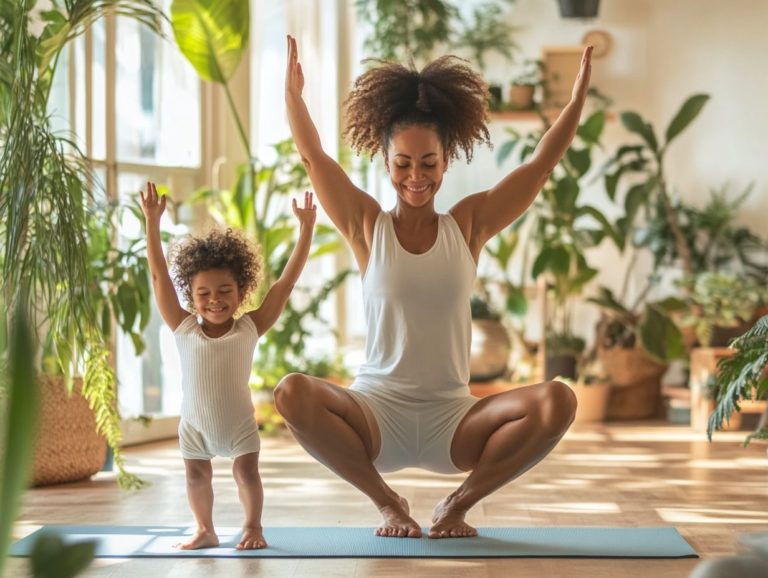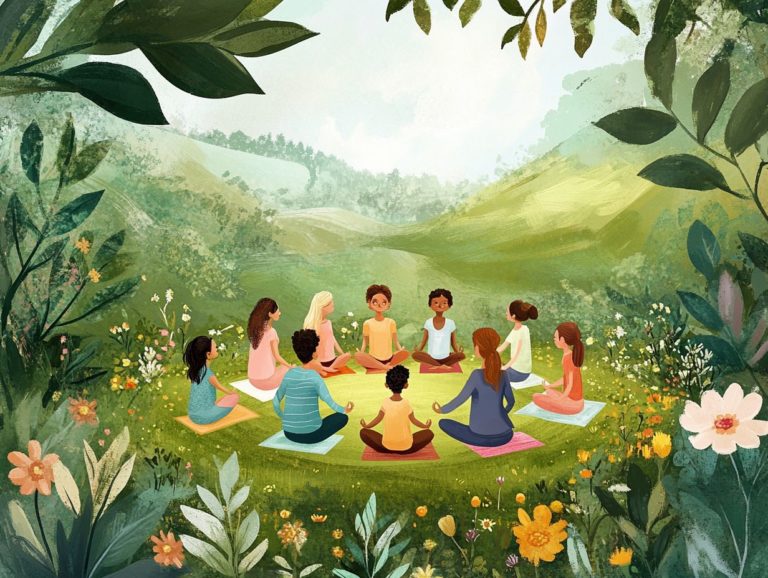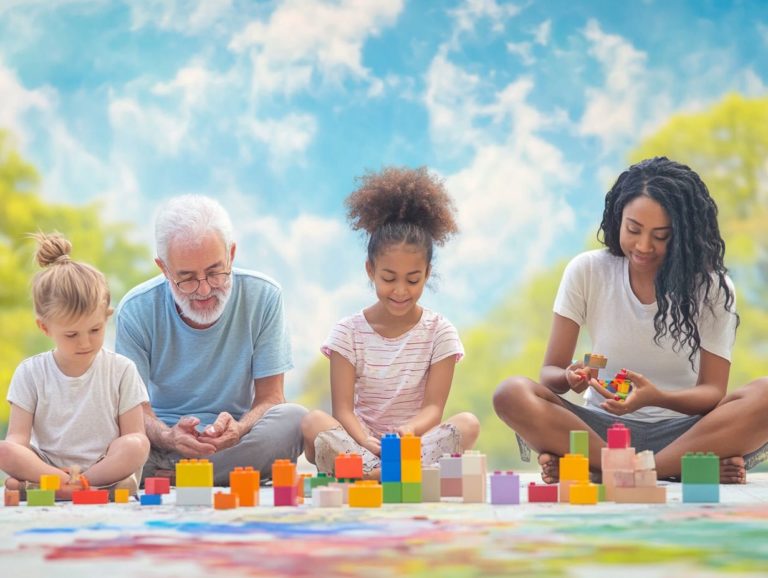Crafting Mindfully: Art Projects for Families
Contents
- Creative Family Crafting Projects
- Incorporate Techniques Like Splatter Art and Breathing Sticks
Creative Family Crafting Projects
Crafting together as a family transcends mere entertainment; it’s an exceptional opportunity to strengthen bonds, ignite creativity, and promote learning in a meaningful way.
Discover ten captivating art projects that incorporate natural materials, recycled items, and personal touches to create unforgettable experiences. Each project not only nurtures artistic expression but also cultivates essential skills and encourages mindfulness.
Dive into this thrilling creative journey today and witness how crafting can enhance your family’s connections while contributing positively to the community. Embrace mindful practices and calming activities to enrich your creative experience.
Key Takeaways:
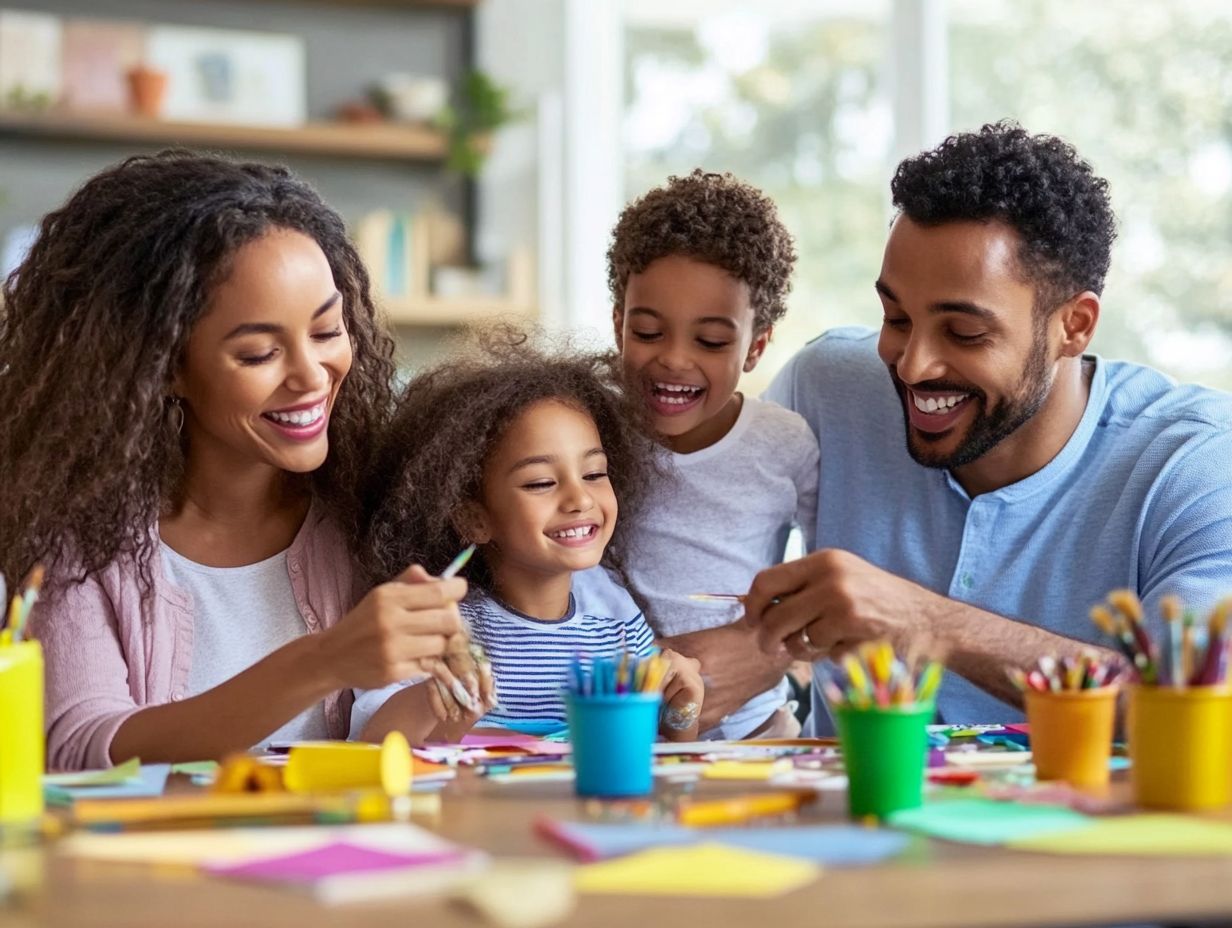
- Crafting together as a family promotes bonding and strengthens relationships through shared art activities.
- Crafting helps children develop important skills such as creativity, problem-solving, and fine motor skills.
- Mindful crafting with children involves being present and focusing on the process rather than the end result.
1. Painting with Natural Materials
Explore Zentangle Art Techniques
Painting with natural materials offers you a remarkable opportunity to engage children in a mindful practice. It nurtures creativity and self-awareness while forging a deeper connection to the environment.
By utilizing elements like leaves, flowers, and soil, children can delve into a world of colors and textures, discovering the creative wonders that nature provides. This approach sharpens their artistic skills and introduces relaxation techniques that enhance emotional intelligence and support mental health.
Imagine incorporating materials such as crushed berries for vibrant hues, twigs for unique brush strokes, and clay mixed with natural pigments. This opens up a rich tapestry of artistic possibilities.
Activities like creating a leaf collage or painting with earth tones serve as calming practices that allow children to fully immerse themselves in the moment, expressing their feelings in a creative way.
As they engage in these mindful art activities, they improve their emotional awareness and resilience, transforming the creative process into a healing experience. This not only fosters relaxation but also bolsters their overall well-being, equipping them with invaluable coping strategies to manage stress and anxiety.
2. Creating a Nature Collage
Experience the Joy of Fairy Glow Jars and Glitter Sensory Bottles
Creating a nature collage invites you to practice mindfulness by immersing yourself in the textures and colors found in the natural world. It nurtures artistic expression and creativity.
This activity aligns perfectly with creating fairy glow jars and glitter sensory bottles, adding a magical touch to the experience.
As you collect materials like leaves, twigs, and flowers from your surroundings, you engage with nature in a meaningful way. This gathering deepens your understanding of the elements in your environment and offers a moment for reflection and connection with the earth.
Throughout this process, mindful breathing serves as your guiding technique. As you intentionally inhale and exhale, you become more attuned to the present moment. This practice enhances your emotional intelligence, allowing you to recognize and express your feelings through art.
It also helps you manage your emotions, transforming the collage-making experience into a therapeutic journey that uplifts your spirits and ignites joy.
3. Making Homemade Playdough
Explore Flextangles and Doodle Art
Creating homemade gingerbread playdough is not just a delightful activity for children; it s an enriching experience that nourishes their creativity and sensory engagement. It also promotes a sense of relaxation. Combining this with activities like making flextangles or engaging in doodle art can further enhance their creative exploration.
With simple ingredients like flour, salt, water, cream of tartar, vegetable oil, and aromatic spices such as cinnamon or ginger, you ll craft a dough that tantalizes the senses. The warm, inviting fragrance fills the air. As children knead and mold the playdough, they engage their tactile senses, fostering a deeper connection to the present moment. This hands-on experience can be elevated by encouraging them to shape figures or create scenes, allowing for authentic expression and exploration of their emotions.
Playdough serves a unique purpose in therapeutic settings. Its soft and easy-to-mold nature aids in soothing anxiety and enhancing emotional intelligence. This playful medium helps children recognize and articulate their feelings in a manner that is both enjoyable and meaningful.
4. Creating a Family Art Journal
Incorporate Mandalas and Mindfulness Coloring
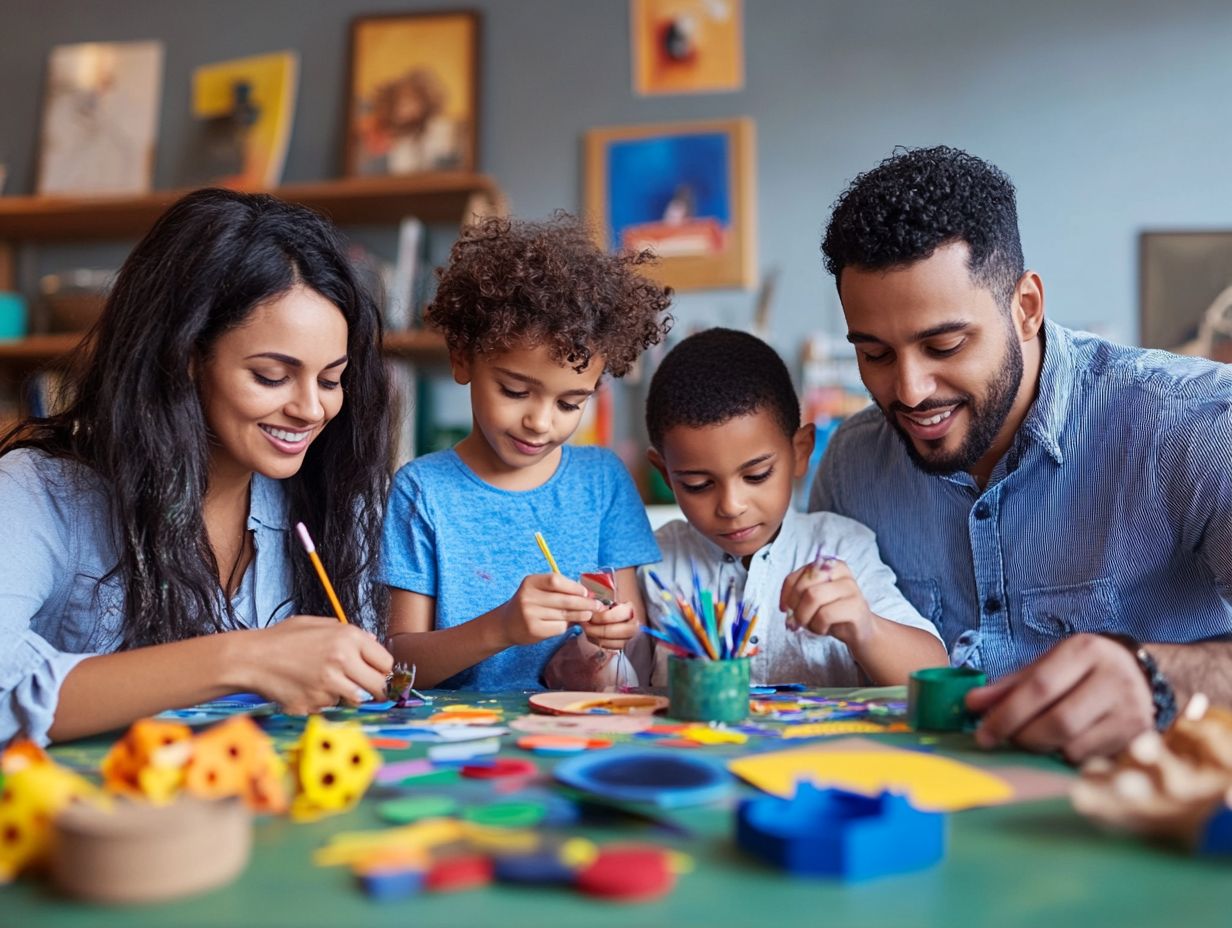
Creating a family art journal is a transformative way for you and your children to engage in mindful practices together. It fosters emotional connection and self-expression through art activities. Incorporate techniques like splatter art and using breathing sticks to enhance your creative sessions.
This collaborative experience not only nurtures creativity but also provides a safe space for everyone to document their thoughts and feelings as they grow. Use prompts like “What made you smile today?” or “Draw a memory that makes you feel happy.” These can significantly enhance emotional intelligence. Exploring themes such as gratitude, dreams, or personal challenges helps cultivate a deeper awareness and understanding of one s emotions. Incorporating activities like drawing mandalas or mindfulness coloring pages can bring additional layers of calmness and focus.
Incorporating relaxation techniques, like deep breathing exercises, before starting an art session can further enhance focus and promote a calming atmosphere. This blend of artistic expression and mindful reflection becomes a powerful tool for families to connect on a deeper level.
Why wait? Dive into creating your family art journal today!
5. Making Recycled Art
Discover Butterfly Symmetry Painting and Mindfulness Rocks
Creating recycled art presents you with an innovative and eco-friendly opportunity to engage children in a mindful practice that fosters creativity, resourcefulness, and environmental awareness. Discover techniques like butterfly symmetry painting and crafting mindfulness rocks to expand your artistic horizons.
Gather materials like plastic bottles, cardboard, and old magazines. Children will gain insights into recycling and discover the beauty of reimagining everyday objects. They can craft vibrant collages, intricate sculptures, or even practical items like planters or clocks. This hands-on experience nurtures emotional intelligence, allowing children to convey their feelings and thoughts through art.
Meanwhile, mindfulness flourishes as they immerse themselves in the creation process, reveling in the joy of transforming waste into artistic treasures.
6. Building a Fairy Garden
Incorporate Straw Painting and Blow Painting
Building a fairy garden is a delightful opportunity to practice mindfulness while connecting with nature. It s a marvelous way to foster your creativity and nurture your imagination. Incorporate techniques like straw painting and blow painting to create whimsical and colorful elements within your garden.
As you gather various materials small pebbles, twigs, and leaves along with miniature figurines and vibrant, colorful stones craft enchanting landscapes that truly ignite your creative spirit. Adding natural elements like moss or small succulents enhances the visual allure of your garden and instills a sense of responsibility as you learn to care for your miniature ecosystem.
Engaging in this calming activity can greatly improve your emotional intelligence and self-awareness. While reflecting on your thoughts and feelings during the crafting process, you ll cultivate improved focus, patience, and problem-solving skills.
7. Designing and Painting Rocks
Explore Scribble Art and Tile Stencil Art
Designing and painting rocks is a simple yet impactful mindful practice that invites you to express your creativity while exploring colors and patterns in a soothing and therapeutic way.
The journey begins by gathering smooth, flat stones from nature, each serving as a unique canvas for your artistic vision. Once you’ve collected your rocks, experiment with various painting techniques. Try pointillism, where you place small dots of color to create intricate images, or doodle art, allowing for spontaneous and whimsical designs.
These techniques encourage you to focus and immerse yourself in the process, fostering a sense of calm and relaxation. As you paint, weave positive affirmations into your designs, reinforcing feelings of self-worth and mindfulness. You’ll nurture your artistic skills while promoting emotional well-being, making it a delightful and enriching journey for any young artist!
Experiment with scribble art and tile stencil art to add unique textures and patterns to your painted rocks.
8. Making Paper Mache Bowls
Discover the Art of Petal Art and Lemon Stamping
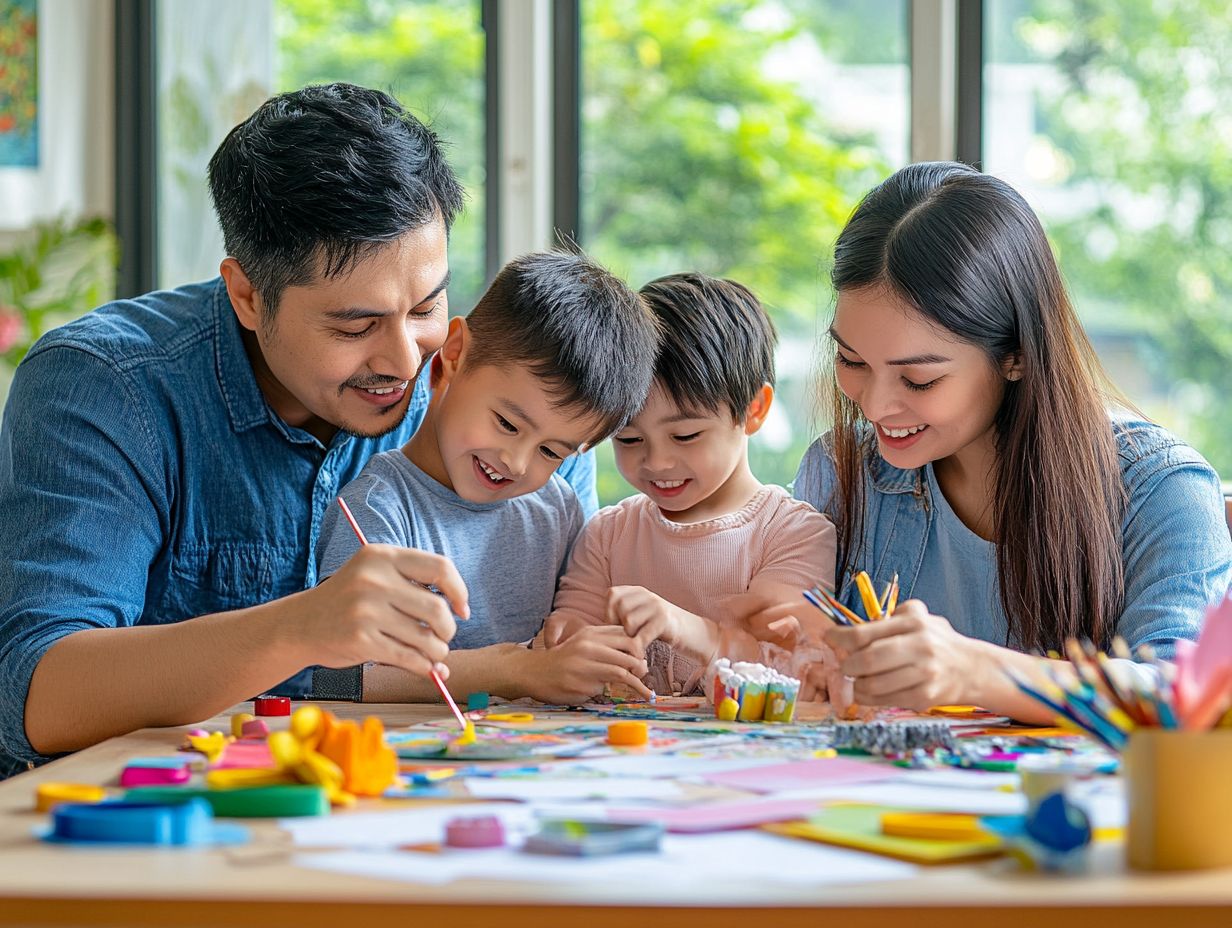
Making paper mache bowls offers you a wonderfully hands-on, creative activity that promotes mindfulness and relaxation through the tactile and artistic process.
This engaging craft invites you to utilize simple materials like newspaper, flour, water, and a balloon as a base, allowing you to dive into a vibrant and enjoyable experience. As you tear strips of paper and carefully apply them to the form, you ll explore your imagination while honing your fine motor skills.
Enhance this experience by discovering the art of petal art and lemon stamping, adding intricate designs and patterns to your creations. You’ll feel a great sense of accomplishment as you create something beautiful!
This delightful activity acts as a therapeutic practice, encouraging you to focus on your movements and the textures of the materials. Don’t miss out on the joy of creating!
Delving into such creative endeavors can significantly reduce stress and enhance your overall sense of well-being, making it an ideal outlet for expression and creativity.
9. Creating a Family Quilt
Incorporate Techniques Like Splatter Art and Breathing Sticks
Creating a family quilt is not just a craft; it s a meaningful endeavor that invites you and your children to practice mindfulness. It nurtures emotional intelligence and fosters a strong feeling of belonging through the beauty of collaborative art.
This mindful practice fosters a deep connection and helps in creating lasting memories. Every member of your family can contribute their unique design, reflecting their personality and experiences.
This transforms the quilt from a mere decorative item into a rich tapestry of familial bonds. As you select colors and patterns together, you ll find opportunities to reflect on feelings and memories.
This can spark deeper conversations, enhance self-awareness, and promote a greater understanding among everyone involved. The entire process of sewing from choosing fabrics to piecing it all together fosters teamwork and encourages each person to express themselves creatively.
Such art activities can be both therapeutic and enjoyable! Ultimately, the quilt evolves into a cherished heirloom, embodying shared moments and nurturing a sense of unity and appreciation within your family.
10. Making Handmade Cards
Creating handmade cards offers you a delightful opportunity to practice mindfulness while unleashing your creativity. You can share joyful messages with those you cherish. These cards can be part of calming activities that help reduce stress and anxiety.
This artistic journey captivates your imagination and invites you to explore an array of techniques and materials. These include textured papers, vibrant markers, and the enchanting inclusion of nature-inspired elements like dried flowers.
A particularly uplifting approach involves utilizing affirmation rocks, which are small rocks with positive messages. This prompts you to contemplate uplifting messages that can be transformed into stunning cards.
Techniques like zentangle art, tile stencil art, and pointillism can add unique touches to your creations. When you share these crafted cards, you significantly enhance your relationships.
They become heartfelt tokens of affection that promote positive emotions and foster a sense of connection. Whether it s a birthday greeting or a simple note of encouragement, giving a handmade card is not just a kind act it s a powerful way to boost mental well-being and emotional intelligence!
How Can Crafting Together as a Family Promote Bonding?
Crafting together as a family doesn t just spark creativity; it cultivates meaningful bonding experiences. These enhance emotional intelligence and mental well-being through shared mindful practices.
Engaging in creative activities like painting, scrapbooking, or building model kits encourages everyone to express their thoughts and feelings. This opens the door to deeper conversations that strengthen trust and understanding among family members.
Both parents and children revel in the laughter and joy from creating something unique! They learn essential lessons in patience and cooperation.
Activities like splatter art, blow painting, and straw painting can further enhance this creative process. Crafting activities such as pottery, sewing, or creating miniature peace gardens provide not only a canvas for artistic expression but also a pathway to mindfulness.
These sessions help everyone stay anchored in the present moment. They can greatly reduce stress! Furthermore, they enable communication and forge cherished memories that will last a lifetime.
What Are the Benefits of Crafting for Children?
Crafting brings exciting benefits for your child’s development! It helps improve fine motor skills, sparks creativity, and provides valuable opportunities for practicing mindfulness, all contributing to their overall emotional intelligence.
Engaging in various craft activities encourages managing their own actions. Children learn to follow instructions and manage their materials effectively. For example, activities like building models with clay, assembling intricate bead designs, or creating gingerbread playdough nurture problem-solving skills.
When faced with challenges, such as balancing different elements in their creations, children also develop resilience and adaptability.
The therapeutic nature of art projects whether it s painting, collage making, or creating mindfulness rocks offers a calming effect. This helps youngsters express their emotions while promoting mindfulness and focus. These experiences enhance their artistic abilities and equip them with essential life skills crucial for their emotional and social development.
How Can Crafting Help Develop Important Skills?
Engaging in crafting cultivates essential skills in children, such as critical thinking, creativity, and emotional expression. It also offers a valuable platform for mindfulness and self-discovery. Fun and educational activities include creative projects like fairy glow jars, butterfly symmetry painting, and lemon stamping.
Through hands-on activities in various projects, young minds learn the art of collaboration. They efficiently work with peers to foster teamwork by sharing ideas and blending their unique strengths to create something truly meaningful.
Creating doodle art or flextangles can be particularly engaging and collaborative. The crafting process requires patience. Children learn to navigate challenges and setbacks with resilience an experience that plays a crucial role in enhancing their emotional intelligence.
Techniques such as mindful mandala hands and breathing sticks teach patience and mindfulness effectively. By working towards shared goals and overcoming obstacles, children sharpen their problem-solving abilities and develop emotional management skills, building confidence along the way.
These experiences ultimately support their overall mental health and well-being, laying a strong foundation for their future. Reading books like “Crafting Calm: Art and Activities for Mindful Kids” can provide additional inspiration and ideas.
What Are Some Tips for Crafting Mindfully with Children?
Crafting mindfully with children requires a deliberate focus and presence. This can truly enhance the creative process. By engaging this way, you foster emotional intelligence and self-regulating power through shared experiences that resonate deeply.
To cultivate an environment that nurtures this mindfulness, establish a quiet and organized workspace. Keep it free from distractions that might disrupt creativity. Before jumping into the crafting activity, take a moment to set clear intentions. Discuss with the children what they hope to achieve or explore during the session.
Activities like creating a mindful breathing wand or engaging in mindfulness coloring help set a focused tone. Incorporating simple relaxation techniques, such as deep breathing or stretching, can elevate the atmosphere further, allowing everyone to immerse themselves fully in the activity.
Relaxation techniques like using breathing beads or drawing your breath can also be beneficial. This journey encourages each participant to be present and heightens their awareness of sensations, thoughts, and feelings.
As a result, crafting transforms from a mere task into a meaningful experience. It deepens connections to the moment and to one another. The sensory experience from such mindful activities can be profoundly enriching. So don t miss out on these incredible opportunities for growth try crafting with your children today!
How Can Crafting Help Reduce Stress and Promote Relaxation?
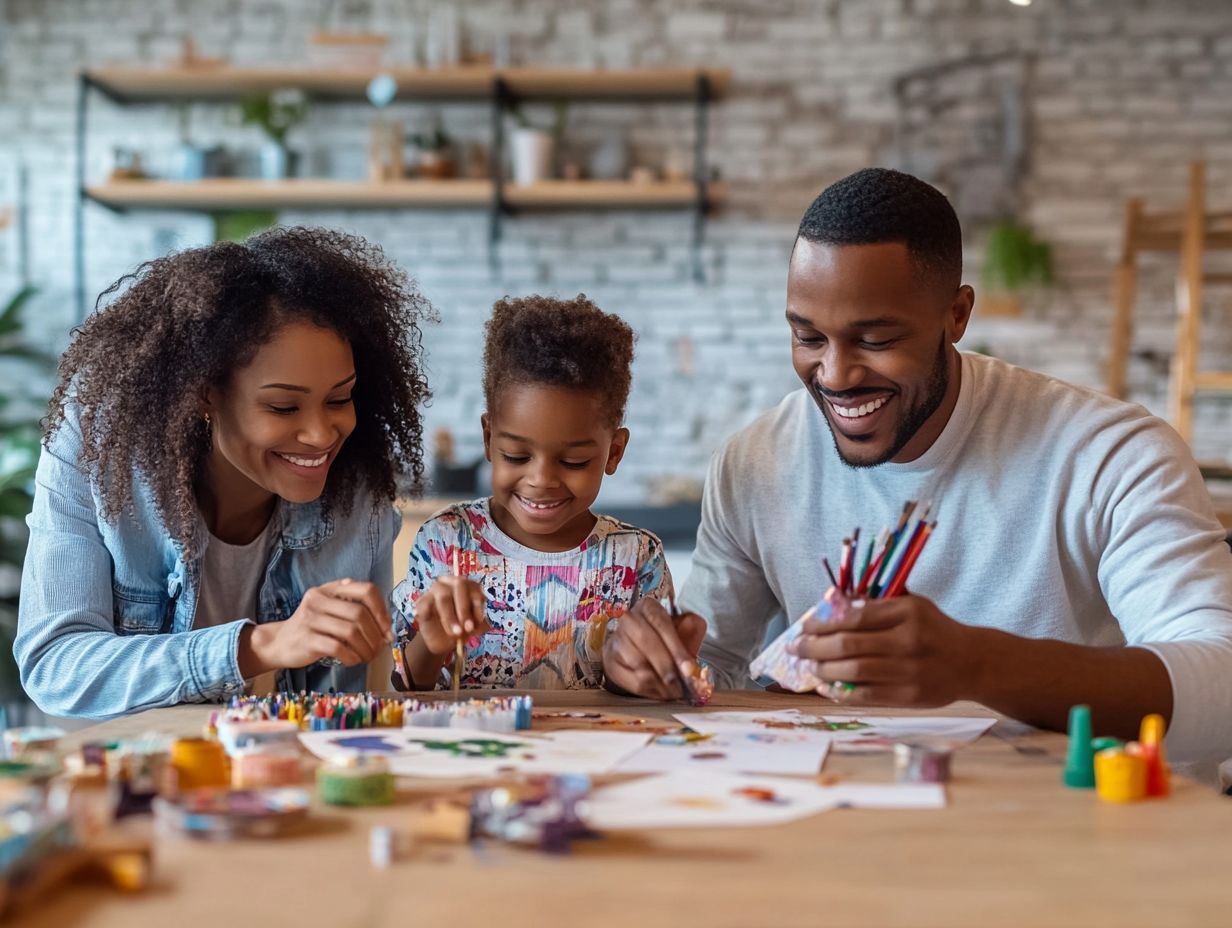
Crafting serves as a powerful tool for reducing stress and fostering relaxation, inviting you to engage in mindful activities that channel your attention and creativity. This practice can also enhance emotional intelligence and self-awareness.
As you immerse yourself in the rhythmic motions of knitting or crocheting, you often discover a state of tranquility where each loop and stitch transforms into a form of meditation. Similarly, when you pick up a paintbrush or grab some coloring pencils, you tap into your imagination, encouraging a flow state, which means you feel completely immersed and lose track of time. This can be especially therapeutic and beneficial for mental health.
For those who relish hands-on creativity, activities like pottery and scrapbooking allow for self-expression and give a hands-on experience that feels grounding. Creating fairy glow jars or upcycle jars can add a magical touch to these experiences.
These diverse crafting pursuits cultivate focus and emotional balance, providing you with a fulfilling way to process feelings and experience a genuine sense of accomplishment. Incorporating positive affirmations can enhance the overall benefits.
What Are Some Ideas for Using Art to Give Back to the Community?
Dive into community art projects! These mindful crafts can make a huge difference for both the creators and the recipients, encouraging children to embrace mindfulness and compassion, fostering a deep sense of connection and responsibility toward others.
When you engage in community art projects, like bringing vibrant murals to life in local parks or crafting handmade cards to uplift the spirits of patients in nearby hospitals, you witness the profound impact these experiences can have on young participants. These activities not only allow children to tap into their creativity but also impart vital lessons about empathy and civic duty. Crafting glitter sensory bottles or mindfulness rocks for community spaces can also be inspiring projects.
Initiatives such as painting mindfulness rocks, which can be placed in public spaces to inspire positivity and reflection, create wonderful opportunities for children to bond with their peers. Collectively, these endeavors nurture a sense of belonging while promoting well-being within the community, crafting an environment where kindness and artistry can truly flourish. Activities like creating mindful zen gardens or petal art can also be impactful.
Frequently Asked Questions
Here are some common questions about crafting mindfully and its benefits for families.
1. What is crafting mindfully and how can it benefit families?
Crafting mindfully is the practice of creating art projects with intention and purpose, focusing on the present moment and being fully engaged in the process. It can benefit families by providing quality time together, promoting creativity and self-expression, and reducing stress and anxiety.
2. What are some examples of art projects that families can do together?
There are many different types of art projects that families can do together, such as painting, drawing, collage, pottery, and more. Some specific ideas include creating a family vision board, making a collaborative painting or sculpture, or designing personalized t-shirts or mugs.
3. How can families incorporate mindfulness into their art projects?
Families can incorporate mindfulness into their art projects by setting intentions before beginning, using deep breathing and relaxation techniques, and staying present and focused on the process rather than the end result. They can also incorporate elements of nature or gratitude, such as making mindfulness rocks, butterfly symmetry painting, or creating miniature peace gardens, into their art to enhance mindfulness. This mindful practice can be a therapeutic nature activity and promote self-awareness.
Start your creative adventure now and discover the joy of crafting mindfully!
4. Is it important to include all family members in crafting mindfully?
All family members, including children, should ideally be involved in crafting mindfully. This fosters togetherness and bonding. If some members can’t join, that s perfectly fine. Creating a welcoming atmosphere is key to involving everyone in the fun! You can include engaging art activities like zentangle art or glitter sensory bottles.
5. Can crafting mindfully help improve communication within families?
Yes, crafting mindfully enhances family communication. It offers a shared activity that encourages open and honest expression. You can connect and understand each other’s perspectives through projects like making affirmation rocks or a mindful mandala.
6. How can families continue to practice crafting mindfully after completing a project?
After finishing an art project, families can weave mindful crafting into their daily routines. Set aside specific times for creative activities like doodle art or tile stencil art. Incorporate mindfulness exercises such as breathing sticks alongside these tasks. Making time to reflect and express gratitude as a family can also promote calmness. Create a mindful zen garden or practice mindful breathing wand exercises together!

